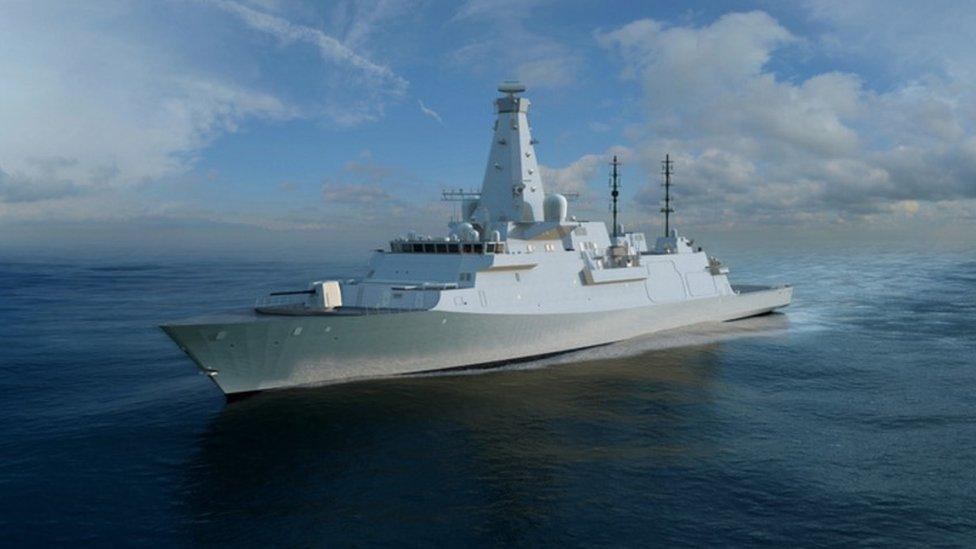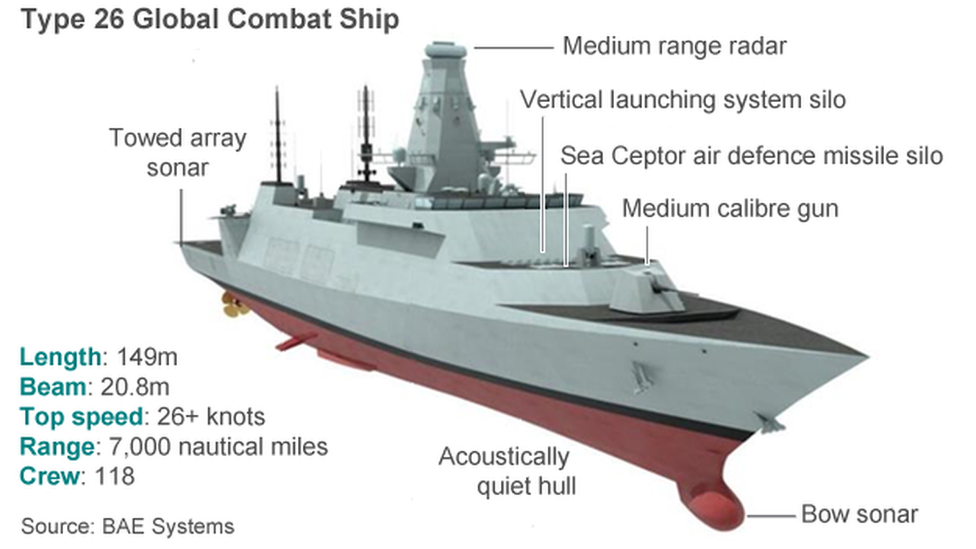Work on eight Type 26 frigates to begin in Summer 2017
- Published
- comments

Work on building eight Type 26 frigates at shipyards in Glasgow will start next summer, the defence secretary has said.
Michael Fallon said the date for cutting the first steel would safeguard hundreds of skilled jobs until 2035.
He also announced that a contract for two new offshore patrol vessels would be signed shortly, securing jobs before the Type 26 frigate work is under way.
Unions welcomed the news but said the UK government had not delivered on all promises made to the Clyde shipyards.

Mr Fallon also announced a £100m contract with the consortium MBDA to deliver the Sea Ceptor missile defence system for the ships.
The Type 26 frigate is principally designed for anti-submarine warfare and will partially replace the current Type 23 frigate.
Each ship will carry a crew of 118, have a top speed of more than 26 knots and a range of 7,000 nautical miles. The first vessel is due to enter service in the early 2020s.
Decades of work
An £859m initial development deal to build the combat ships, at BAE's Govan and Scotstoun yards on the River Clyde in Glasgow, was signed in February 2015.
But the project has been scaled back from an initial 13 ships to eight and hit by repeated delays, with concerns that jobs could be lost as a result.
Michael Fallon: Clyde yards to begin Type 26 frigates in 2017
Mr Fallon, who is visiting the BAE yard at Govan, told the BBC's Good Morning Scotland programme that the announcement was a "huge moment for the Clyde".
"We are confirming we are going ahead with the steel cut next summer, quite a bit earlier than some suggested, of the first of the eight Type 26s that we pledged to in the strategic defence review last year," he said.
"This is work for the next 20 years building these eight Type 26 anti-submarine frigates."
The defence secretary added: "We also hope to conclude, before Christmas by the way, the negotiations on the two offshore patrol vessels that were also promised in the strategic defence and security review last year, which will help fill in the gap before the work on the Type 26 starts."
The promise of new Royal Navy orders to secure the Clyde shipbuilding industry was made before the Scottish independence referendum in 2014.
The number of planned new frigates was later scaled back from 13 to eight in the Strategic Defence Review, with the MoD now planning to build five smaller Type 31 warships in addition to the Type 26 fleet.
'Disappointing' delays
First Minister Nicola Sturgeon welcomed the announcement but pointed out that it was not the same deal that was promised before the referendum.
"The promise hasn't been kept in full, so the number has reduced and there has been a real delay in getting this work started," she said.
Ms Sturgeon described the delay as "regrettable" and "disappointing" and said it had been a source of anxiety for the workforce at both yards.
She added: "Nevertheless, it's a welcome announcement and I really hope now that it doesn't slip any further and that the commitment that has been made today is delivered in full."

Steel cutting will begin next year at the Clyde shipyards
Gary Smith of the GMB union said it was "fantastic news" for the upper Clyde shipyards - though he said the UK government had not delivered on all its promises.
He told Good Morning Scotland: "We were told there was going to be a 'frigate factory' built on the Clyde that would allow us to deliver ships more efficiently.
"It would perhaps have given us the facility to build ships that could be exported.
"And Michael Fallon in truth was dragged kicking and screaming to this announcement today after we exposed the fact that his government did plan to move some of the work originally planned for the Clyde, down south.
"But cutting through it all, great news for the workforce and great news for the economy in greater Glasgow as well."
The Unite union said the announcement safeguarded shipbuilding at the two Clyde yards "for the next generation".
'Safeguarding skills'
The union's regional coordinating officer, Kenny Jordan, said: "Our members have been living with uncertainty for too long and this is a testament to the lobbying and campaigning that they have done over the last two years.
"We have a workforce at Govan and Scotstoun with world-class skills who are eager to get on with the job - and eager to see more work coming in the future.
"This announcement secures the future of shipbuilding on the upper Clyde, supports skilled jobs in manufacturing and will provide opportunities for apprentices and trainees, making sure that we safeguard skills for the next generation."
The defence secretary said design work on the Type 31s was ongoing and he was unable to promise the work would come to the Clyde yards.
But he told the BBC that BAE systems would be in "pole position" to win the orders.
Work on the frigates was originally due to start this year. Unions raised concerns in April that up to 800 jobs could be lost at the Clyde shipyards if there was any backsliding on commitments.
The yards currently employ more than 2,500 people, though hundreds of jobs have been lost over the past two years as BAE has reduced shipbuilding capacity.
Scottish Economy Secretary Keith Brown also welcomed the news as a "tribute to the skilled and dedicated workforces at Govan and Scotstoun", but criticised the "continuing wait" for the MOD's basing review in Scotland to be completed.
The Scottish government has written to Mr Fallon asking for a meeting to discuss plans for base cuts in Scotland, with sites like Fort George and Kinloss facing an uncertain future.

Timeline: Type 26 frigates and the Clyde

25 March 2010: BAE signs £127m contract, external to design Type 26 frigates for Royal Navy
11 October 2010: Sixth and last of the Royal Navy's new Type 45 Destroyers launched on the River Clyde
6 November 2013: Scottish Secretary warns that plans to build new Royal Navy vessels in Glasgow could be endangered by a Yes vote in independence referendum
1 December 2014: Defence Secretary Michael Fallon confirms the UK's new warships will be built on the Clyde
20 February 2015: Ministry of Defence signs £859m initial development deal on Type 26 Frigate. Manufacturing phase is expected to begin in 2016.
23 November 2015: Prime Minister David Cameron announces in defence review that eight new Type 26 Global Combat Ships will be built on the Clyde, scaling back on initial plans for 13 warships
23 April 2016: First Minister Nicola Sturgeon calls for "cast iron assurances" jobs will not be lost at Clyde shipyards because of contract delays
27 June 2016: No deal to build new generation of Royal Navy warships will be signed until it offers "value for money", Mr Fallon says
19 October 2016: UK government refuses to say when the next generation of Royal Navy warships will be built
4 November 2016: Defence secretary confirms first steel on the new frigates will be cut in the summer of 2017 with contracts for two offshore patrol vessels to be signed shortly.
- Published19 October 2016

- Published21 July 2016

- Published27 June 2016

- Published7 June 2016
